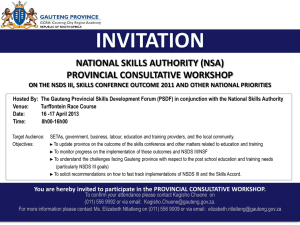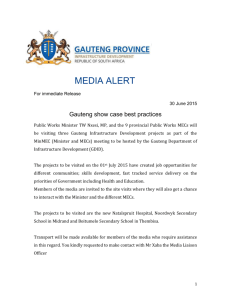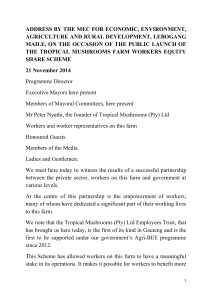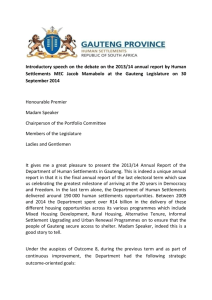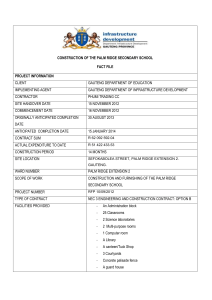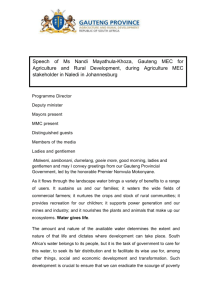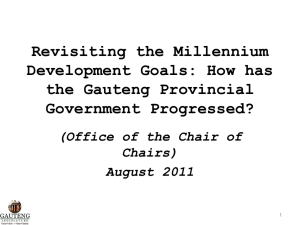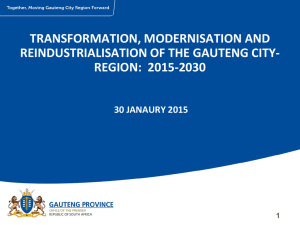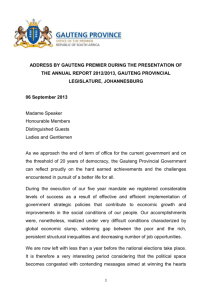Gauteng 2055 FAQs
advertisement
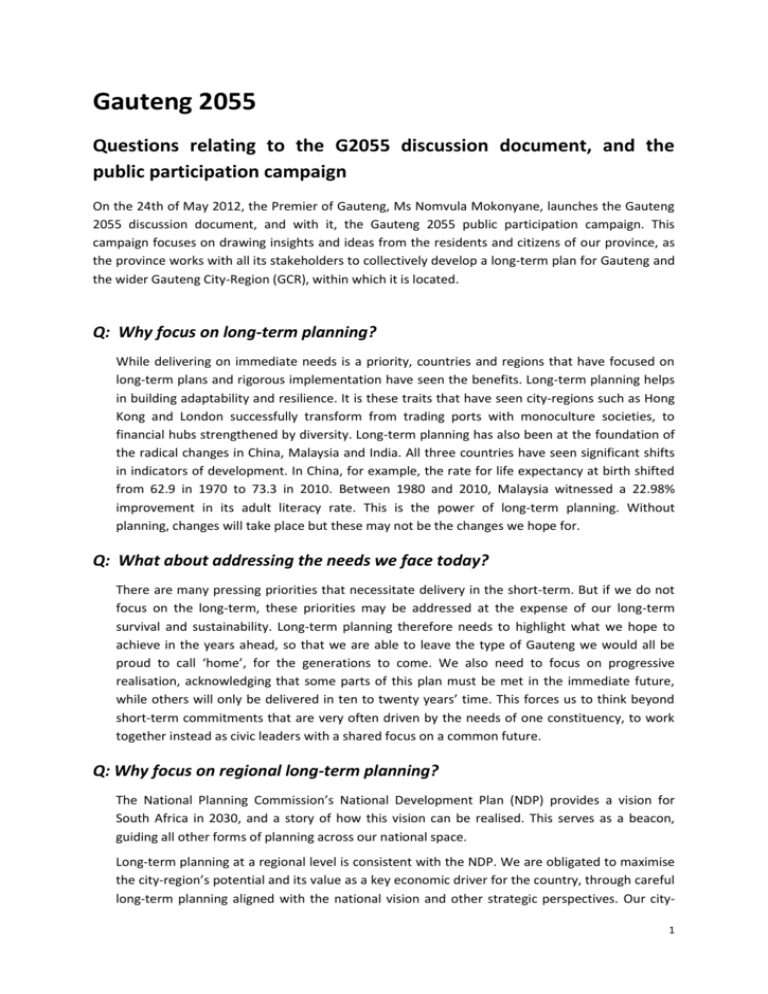
Gauteng 2055 Questions relating to the G2055 discussion document, and the public participation campaign On the 24th of May 2012, the Premier of Gauteng, Ms Nomvula Mokonyane, launches the Gauteng 2055 discussion document, and with it, the Gauteng 2055 public participation campaign. This campaign focuses on drawing insights and ideas from the residents and citizens of our province, as the province works with all its stakeholders to collectively develop a long-term plan for Gauteng and the wider Gauteng City-Region (GCR), within which it is located. Q: Why focus on long-term planning? While delivering on immediate needs is a priority, countries and regions that have focused on long-term plans and rigorous implementation have seen the benefits. Long-term planning helps in building adaptability and resilience. It is these traits that have seen city-regions such as Hong Kong and London successfully transform from trading ports with monoculture societies, to financial hubs strengthened by diversity. Long-term planning has also been at the foundation of the radical changes in China, Malaysia and India. All three countries have seen significant shifts in indicators of development. In China, for example, the rate for life expectancy at birth shifted from 62.9 in 1970 to 73.3 in 2010. Between 1980 and 2010, Malaysia witnessed a 22.98% improvement in its adult literacy rate. This is the power of long-term planning. Without planning, changes will take place but these may not be the changes we hope for. Q: What about addressing the needs we face today? There are many pressing priorities that necessitate delivery in the short-term. But if we do not focus on the long-term, these priorities may be addressed at the expense of our long-term survival and sustainability. Long-term planning therefore needs to highlight what we hope to achieve in the years ahead, so that we are able to leave the type of Gauteng we would all be proud to call ‘home’, for the generations to come. We also need to focus on progressive realisation, acknowledging that some parts of this plan must be met in the immediate future, while others will only be delivered in ten to twenty years’ time. This forces us to think beyond short-term commitments that are very often driven by the needs of one constituency, to work together instead as civic leaders with a shared focus on a common future. Q: Why focus on regional long-term planning? The National Planning Commission’s National Development Plan (NDP) provides a vision for South Africa in 2030, and a story of how this vision can be realised. This serves as a beacon, guiding all other forms of planning across our national space. Long-term planning at a regional level is consistent with the NDP. We are obligated to maximise the city-region’s potential and its value as a key economic driver for the country, through careful long-term planning aligned with the national vision and other strategic perspectives. Our city1 region is spatially, socially and economically unique. By engaging in regional long-term planning, we recognise our responsibility to build on what we have to offer – not only for the benefit of all who live and work here, but more broadly, for the nation as a whole, and for the wider subSaharan region. Long-term regional planning is also essential for the establishment of a resilient and sustainable Gauteng City Region that is able to meet the needs all our present and future needs. Q: Why focus on 2055? The year 2055 is emphasised for two reasons. Firstly, it marks the 100th year anniversary of the Freedom Charter. The values, rights and freedoms committed to in 1955 are as relevant now as they were then, with many of these ideals reflected in our Constitution. Many have been progressively realised during the growth of our democracy. It is therefore symbolic, while also defining a clear point in time at which we can review and hopefully confirm achievement of these dreams, for everyone within and beyond the GCR. Secondly, planning for 2055 also allows us to plan for generational change – building the types of radical change that is only possible over three or four generations. We hope to change the very things that threaten our Constitutional democracy. With 43 years providing the opportunity to create radical change, shifting our education outcomes, our spatial realities, our unemployment levels, and the poverty and inequalities that still afflict many who live and work in Gauteng. While 2055 represents a point that is far enough into the future as to be unimaginable, it is exactly this which we must plan for – growing resilience and our ability to adapt to the unknown. Q: What is the GCR – and where is it? The geographical area we refer to as the GCR is a space that includes and stretches beyond the administrative boundaries of our province. It represents the functional flow of our economy and the movement of people, goods, services, trade and investment. Its borders are not firmly defined or reflected in any political or administrative structures, but instead represent our understanding of the way in which the spatial economy works. If we were to envisage the GCR’s economic ‘footprint’, it would include the core urban region with its three metros (Tshwane, Ekurhuleni and Johannesburg), a number of secondary cities, and the various areas with which we have strong economic linkages. There are strong economic linkages between the GCR’s core and the nearby cities of Rustenburg, Sasolburg, the region around Potchefstroom and Klerksdorp, and the Witbank-Middleburg-Secunda region. This footprint relates directly to the extent of economic collaboration and connectivity across the geography. This imaginary boundary may shift over time as the levels of interconnectivity evolve, but the current thinking provides a useful framework for planning. Q: How does this fit with the concept of a ‘global city-region’? Global city-regions are recognised as large functional areas that often have an urban core, with borders drawn by a number of concentrations, flows and linkages. Most global city regions are characterised by large populations, dense labour markets, commuting flows, spatial agglomeration economies, transport logistics corridors, networks of firms, and particular biophysical variables. Our GCR fits closely with many of these descriptions. Other city-regions 2 include Barcelona, Sao Paolo, Hong Kong, Rio de Janeiro, London, Mumbai, Colombo in Sri Lanka, Santiago de Chile, and New York, to name just a few – all of which experience varying levels of development. Learning from our counterparts helps us draw lessons, so that we too can play the type of useful role performed by other city-regions in countries like Brazil in Singapore, in supporting national growth and development, and the prosperity of their people. Q: Why is the Gauteng Provincial Government releasing a discussion document, instead of a plan? Planning for our collective future requires the input of all, as full participants in the journey to 2055. For this reason, the discussion document the province is launching serves as a platform for a ‘people’s vision’ – rather than a vision of the Gauteng Provincial Government alone. The intention is to initiate a conversation in which all across the city-region can participate and contribute towards a collective set of ideas for a shared future, which will ultimately be included in the Gauteng 2055 plan. The process and outcomes of long-term planning must be owned and driven by all. Q: What type of plan will we eventually create? Plans serve many purposes. They are however only as useful as their implementation. We aim to establish a plan that will support the creation of a liveable, equitable, united and prosperous GCR, through: Allowing us to imagine the future and articulate the different paths to get there – creating a story that makes sense to everyone; Supporting the way we think about and address coordination gaps between the larger metros and connecting spaces, in a dynamic and quickly changing region; Communicating the useful contribution Gauteng can make to national growth and to the prosperity of other provinces, through constructive and focused development; and Supporting internal coordination amongst GPG departments – highlighting the things we really need to change. This is the start of the process. If our plan is able to play this role, it will help us navigate, together, a different path to 2055, so that we are able to realise the ideals contained within our Constitution, and the Freedom Charter. Q: We are known as a nation of planners. What about implementation? Implementation of the Gauteng 2055 plan will depend on us all. There is an ever increasing realisation that the state is only one part of the delivery chain. The discussions ahead will address both the content of the plan – and how we make it work, collectively – through the efforts of all who live and work here. This will be our plan – our story, for our province – and our future. Q: So how do we provide our inputs? 3 All people are invited to provide their inputs and thoughts. A set of targeted stakeholder sessions will be held over the coming months. Discussions will be hosted across the province’s regions, with updates of the programme to be communicated online, and through various media channels. Gauteng 2055 Ward Izimbizos will also be facilitated by community development workers, ward committees and ward councillors, while Parliamentary Constituency Office Izimbizos will be convened by Members of the Provincial Legislature. We will also roll out a door-to-door campaign, gathering inputs from members of the public on their visions for Gauteng in 2055. These efforts will also be supported by Gauteng 2055 kiosks that will be located at various public places across the province, allowing us to gather ideas and insights. A programme of events will be made available on the Gauteng 2055 website: www.gauteng2055.gov.za We will be twittering on @g2055. You will also find our facebook page at www.facebook.co,/G2055. The Gauteng 2055 team can be reached via email, on G2055@gauteng.gov.za. 4
